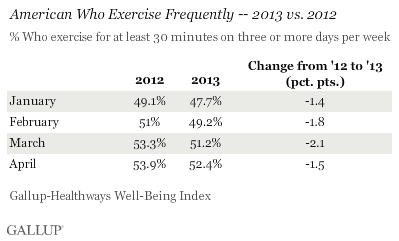WASHINGTON, DC -- The 52.4% of Americans who said they exercised for at least 30 minutes three or more days per week is lower than the 53.9% who said so in April 2012. Frequent exercise is down in general in 2013 compared with 2012. Last year, Americans' exercise habits improved during the warmest year on record for the U.S. since 1895.

The percentage of Americans reporting frequent exercise has been lower in every month of 2013 so far compared with the same month last year, but the 2013 data is in line with the previous two years. This contrasts with 2012, when frequent exercise was higher in almost every month compared with the same months in 2011.

This April broke more than 3,400 cold-weather records across the nation with some cities still receiving snow in early May. It is interesting to note that frequent exercise -- which does follow a typical seasonal pattern of being higher in the spring and summer and lower in the fall and winter -- is indeed down during a time of unusually cold weather and had previously increased amid record-breaking warmth. Frequent exercise in the U.S. hit a five-year high in July of last year, with 55.3% reporting that they exercised for at least 30 minutes three or more days per week.
Bottom Line
After a strong showing in 2012, frequent exercise is back down again in 2013 so far. But, even though fewer Americans are exercising frequently so far this year, at least in April Americans are exercising more than they did in the midst of and during the immediate aftermath of the Great Recession in 2009. They are now about on par with 2011.
But, as the U.S. continues to struggle with obesity, the current minor setback in exercise reveals that the nation has a long way to go in achieving a significant and sustained improvement in health. Indeed, a new report from the U.S. Centers for Disease Control and Prevention finds that while nearly 50% of adults are getting the recommended amounts of aerobic activity, only one in five are meeting the overall guidelines for aerobic and muscle-strengthening physical activity.
About the Gallup-Healthways Well-Being Index
The Gallup-Healthways Well-Being Index tracks well-being in the U.S. and provides best-in-class solutions for a healthier world. To learn more, please visit well-beingindex.com.
Survey Methods
Results are based on telephone interviews conducted as part of the Gallup Healthways Well-Being Index survey April 1-30, 2013, with a random sample of 30,252 adults, aged 18 and older, living in all 50 U.S. states and the District of Columbia. Every month in the tracking period has a sample size of at least 28,000 adults.
For results based on the total sample of national adults, one can say with 95% confidence that the maximum margin of sampling error is ±0.7 percentage points.
Interviews are conducted with respondents on landline telephones and cellular phones, with interviews conducted in Spanish for respondents who are primarily Spanish-speaking. Each sample includes a minimum quota of 400 cell phone respondents and 600 landline respondents per 1,000 national adults, with additional minimum quotas among landline respondents by region. Landline telephone numbers are chosen at random among listed telephone numbers. Cell phones numbers are selected using random digit dial methods. Landline respondents are chosen at random within each household on the basis of which member had the most recent birthday.
Samples are weighted by gender, age, race, Hispanic ethnicity, education, region, adults in the household, and phone status (cell phone-only/landline only/both, cell phone mostly, and having an unlisted landline number). Demographic weighting targets are based on the March 2011 Current Population Survey figures for the aged 18 and older non-institutionalized population living in U.S. telephone households. All reported margins of sampling error include the computed design effects for weighting and sample design.
In addition to sampling error, question wording and practical difficulties in conducting surveys can introduce error or bias into the findings of public opinion polls.
For more details on Gallup's polling methodology, visit www.gallup.com.
